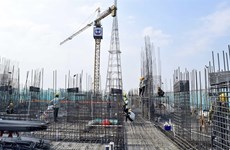Ba Ria-Vung Tau pepper cultivation goes green
Trees producing the quintessential pepper spice cultivated in Ba
Ria-Vung Tau have improved both in quality and yield, as announced at a
workshop held in the southern province on February 11.
Trees producing the quintessential pepper spice cultivated in Ba
Ria-Vung Tau have improved both in quality and yield, as announced at a
workshop held in the southern province on February 11.
The positive result stemmed from a development project focusing on a sustainable pepper supply chain, jointly organised by the provincial Department for Agriculture and Rural Development and the SNV Netherlands Development Organisation and funded by Olam Vietnam Ltd., the leading exporter of agriculture products, including pepper in Vietnam.
The project, implemented from 2013-2015, aims to assist 100 producers to meet the Sustainable Agriculture Standards; to establish direct links between Olam and producers; and to set a solid foundation for future market expansion.
At the workshop, Head of the provincial Rural Development Sub-Division Nguyen Anh Quoc pointed to a number of measures to expand green farming in the future, such as promoting the trademark of local pepper, broadening relevant training courses across the province, and boosting the performance of the provincial pepper association.
According to Quoc, pepper plantations in Ba Ria-Vung Tau currently cover 9,047 hectares, producing 2 tonnes per hectare annually. By 2020, the province targets to limit plantations to 8,300 hectares, but improve yields and bring them up to 2.3 tonnes per hectare annually.
Administrative units from the local agriculture sector warned farmers not to expand their plantations outside officially planned areas, he added.
Ritutapan Neog, Deputy General Manager at Olam International, said the company has made sustainable cultivation methods available for more than 104 farms in the province to date, 98 of which meet criteria to receive the Rainforest Alliance certification designed to generate ecological, social and economic benefits.
According to the SNV, the global market price of pepper has been on the rise over the past few years due to an increase in global demand of the product and a reduction of pepper.
Vietnamese pepper accounts for around 30 percent and 50 percent of the world’s total production and exports, respectively.-VNA
The positive result stemmed from a development project focusing on a sustainable pepper supply chain, jointly organised by the provincial Department for Agriculture and Rural Development and the SNV Netherlands Development Organisation and funded by Olam Vietnam Ltd., the leading exporter of agriculture products, including pepper in Vietnam.
The project, implemented from 2013-2015, aims to assist 100 producers to meet the Sustainable Agriculture Standards; to establish direct links between Olam and producers; and to set a solid foundation for future market expansion.
At the workshop, Head of the provincial Rural Development Sub-Division Nguyen Anh Quoc pointed to a number of measures to expand green farming in the future, such as promoting the trademark of local pepper, broadening relevant training courses across the province, and boosting the performance of the provincial pepper association.
According to Quoc, pepper plantations in Ba Ria-Vung Tau currently cover 9,047 hectares, producing 2 tonnes per hectare annually. By 2020, the province targets to limit plantations to 8,300 hectares, but improve yields and bring them up to 2.3 tonnes per hectare annually.
Administrative units from the local agriculture sector warned farmers not to expand their plantations outside officially planned areas, he added.
Ritutapan Neog, Deputy General Manager at Olam International, said the company has made sustainable cultivation methods available for more than 104 farms in the province to date, 98 of which meet criteria to receive the Rainforest Alliance certification designed to generate ecological, social and economic benefits.
According to the SNV, the global market price of pepper has been on the rise over the past few years due to an increase in global demand of the product and a reduction of pepper.
Vietnamese pepper accounts for around 30 percent and 50 percent of the world’s total production and exports, respectively.-VNA












